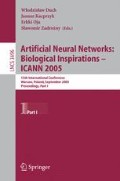Abstract
This paper describes an artificial neural network that can be viewed as an extension of a pioneering network described by Laden and Keefe. This network was trained to classify sets of four musical notes into four different chord classes, regardless of the musical key or the form (inversion) of the chord. This new network has a slightly modified training set; after successful training the internal structure was analyzed and was found to be unique. That is, rather than using the 12 musical notes of Western music, the network used only 4 musical notes based upon circles of major thirds and of minor thirds[1].
Access this chapter
Tax calculation will be finalised at checkout
Purchases are for personal use only
Preview
Unable to display preview. Download preview PDF.
References
Franklin, J.A.: Recurrent neural networks and pitch representations for music tasks. In: Seventeenth International Florida Artificial Intelligence Research Symposium Conference, Miami Beach, FA. AAAI Press, Menlo Park (2004)
Todd, P.M., Loy, D.G.: Music and connectionism, p. xi, 268. MIT Press, Cambridge (1991)
Griffith, N., Todd, P.M.: Musical Networks: Parallel Distributed Perception And Performace, XV, p. 385. MIT Press, Cambridge (1999)
Laden, B., Keefe, B.H.: The representation of pitch in a neural net model of pitch classification. Computer Music Journal 13, 12–26 (1989)
Moody, J., Darken, C.J.: Fast learning in networks of locally-tuned processing units. Neural computation 1, 281–294 (1989)
Dawson, M.R.W.: Minds And Machines: Connectionism And Psychological Modeling. Blackwell Pub., Malden (2004)
Dawson, M.R.W., Schopflocher, D.P.: Modifying the generalized delta rule to train networks of nonmonotonic processors for pattern classification. Connection Science 4, 19–31 (1992)
Krumhansl, C.L.: Cognitive Foundations Of Musical Pitch. Oxford psychology series, vol. 17, p. x, 307. Oxford University Press, New York (1990)
Author information
Authors and Affiliations
Editor information
Editors and Affiliations
Rights and permissions
Copyright information
© 2005 Springer-Verlag Berlin Heidelberg
About this paper
Cite this paper
Yaremchuk, V., Dawson, M.R.W. (2005). Chord Classifications by Artificial Neural Networks Revisited: Internal Representations of Circles of Major Thirds and Minor Thirds. In: Duch, W., Kacprzyk, J., Oja, E., Zadrożny, S. (eds) Artificial Neural Networks: Biological Inspirations – ICANN 2005. ICANN 2005. Lecture Notes in Computer Science, vol 3696. Springer, Berlin, Heidelberg. https://doi.org/10.1007/11550822_94
Download citation
DOI: https://doi.org/10.1007/11550822_94
Publisher Name: Springer, Berlin, Heidelberg
Print ISBN: 978-3-540-28752-0
Online ISBN: 978-3-540-28754-4
eBook Packages: Computer ScienceComputer Science (R0)

